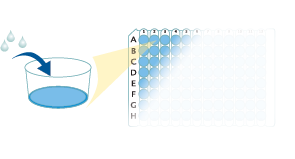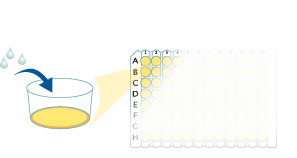Mouse/Rat Flt-3 Ligand/FLT3L Quantikine ELISA Kit Summary
Product Summary
Precision
Cell Culture Supernates, Serum
| Intra-Assay Precision | Inter-Assay Precision | |||||
|---|---|---|---|---|---|---|
| Sample | 1 | 2 | 3 | 1 | 2 | 3 |
| n | 20 | 20 | 20 | 20 | 20 | 20 |
| Mean (pg/mL) | 79.5 | 237 | 775 | 82.4 | 242 | 768 |
| Standard Deviation | 3.9 | 10.1 | 28.6 | 6.2 | 13.6 | 39.4 |
| CV% | 4.9 | 4.3 | 3.7 | 7.5 | 5.6 | 5.1 |
Recovery
The recovery of mouse Flt-3 Ligand spiked to three levels throughout the range of the assay in various matrices was evaluated.
| Sample Type | Average % Recovery | Range % |
|---|---|---|
| Mouse Cell Culture Supernates (n=5) | 99 | 88-107 |
| Mouse Serum (n=5) | 95 | 82-106 |
| Rat Cell Culture Supernates (n=5) | 108 | 99-119 |
| Rat Serum (n=5) | 95 | 86-114 |
Linearity
Scientific Data
Product Datasheets
Preparation and Storage
Background: Flt-3 Ligand/FLT3L
Flt-3 Ligand, also known as FL, is an alpha-helical cytokine that promotes the differentiation of multiple hematopoietic cell lineages. Mature human Flt-3 Ligand consists of a 158 amino acid (aa) extracellular domain (ECD) with a cytokine-like domain and a juxtamembrane tether region, a 21 aa transmembrane segment, and a 30 aa cytoplasmic tail. Within the ECD, human Flt-3 Ligand shares 71% and 65% aa sequence identity with mouse and rat Flt-3 Ligand, respectively. Human and mouse Flt-3 Ligand show cross-species activity. Flt-3 Ligand is expressed as a noncovalently-linked dimer by T cells and bone marrow and thymic fibroblasts. Each 36 kDa chain carries approximately 12 kDa of N- and O-linked carbohydrates. Alternate splicing and proteolytic cleavage of the transmembrane form can generate a soluble 30 kDa fragment that includes the cytokine domain. Alternate splicing of human Flt-3 Ligand also generates membrane-associated isoforms that contain either a truncated cytoplasmic tail or an 85 aa substitution following the cytokine domain. Both transmembrane and soluble Flt-3 Ligand signal through the tyrosine kinase receptor Flt-3/Flk-2. Flt-3 Ligand induces the expansion of monocytes and immature dendritic cells as well as early B cell lineage differentiation. It synergizes with IL-3, GM-CSF, and SCF to promote the mobilization and myeloid differentiation of hematopoietic stem cells. It cooperates with IL-2, -6, -7, and -15 to induce NK cell development and with IL-3, -7, and -11 to induce terminal B cell maturation. Animal studies also show Flt-3 Ligand to reduce the severity of experimentally induced allergic inflammation.
Assay Procedure
Refer to the product- Prepare all reagents, standard dilutions, and samples as directed in the product insert.
- Remove excess microplate strips from the plate frame, return them to the foil pouch containing the desiccant pack, and reseal.
- Add 50 µL of Assay Diluent to each well.
- Add 50 µL of Standard, Control, or sample to each well. Cover with a plate sealer, and incubate at room temperature for 2 hours.
- Aspirate each well and wash, repeating the process 4 times for a total of 5 washes.
- Add 100 µL of Conjugate to each well. Cover with a new plate sealer, and incubate at room temperature for 2 hours.
- Aspirate and wash 5 times.
- Add 100 µL Substrate Solution to each well. Incubate at room temperature for 30 minutes. PROTECT FROM LIGHT.
- Add 100 µL of Stop Solution to each well. Read at 450 nm within 30 minutes. Set wavelength correction to 540 nm or 570 nm.





Citations for Mouse/Rat Flt-3 Ligand/FLT3L Quantikine ELISA Kit
R&D Systems personnel manually curate a database that contains references using R&D Systems products. The data collected includes not only links to publications in PubMed, but also provides information about sample types, species, and experimental conditions.
24
Citations: Showing 1 - 10
Filter your results:
Filter by:
-
PEGylated thrombopoietin mimetic, JNJ?26366821 a novel prophylactic radiation countermeasure for acute radiation injury
Authors: Holmes-Hampton, GP;Kumar, VP;Biswas, S;Stone, S;Sharma, NK;Legesse, B;Vercellino, J;Guha, C;Eichenbaum, G;Ghosh, SP;
Scientific reports
Species: Mouse
Sample Types: Serum
-
Gut dysbiosis promotes the breakdown of oral tolerance mediated through dysfunction of mucosal dendritic cells
Authors: T Fukaya, T Uto, S Mitoma, H Takagi, Y Nishikawa, M Tominaga, N Choijookhu, Y Hishikawa, K Sato
Cell Reports, 2023-04-25;42(5):112431.
Species: Mouse
Sample Types: Serum
-
Activation of neuronal FLT3 promotes exaggerated sensorial and emotional pain-related behaviors facilitating the transition from acute to chronic pain
Authors: A Tassou, M Thouaye, D Gilabert, A Jouvenel, JP Leyris, C Sonrier, L Diouloufet, I Mechaly, S Mallié, J Bertin, M Chentouf, M Neiveyans, M Pugnière, P Martineau, B Robert, X Capdevila, J Valmier, C Rivat
Progress in neurobiology, 2023-01-13;0(0):102405.
Species: Mouse
Sample Types: Tissue Homogenates
-
Engineered Lactococcus lactis secreting Flt3L and OX40 ligand for in situ vaccination-based cancer immunotherapy
Authors: J Zhu, Y Ke, Q Liu, J Yang, F Liu, R Xu, H Zhou, A Chen, J Xiao, F Meng, L Yu, R Li, J Wei, B Liu
Nature Communications, 2022-12-03;13(1):7466.
Species: Bacteria - Lactococcus lactis
Sample Types: Cell Lysates
-
Pre-Administration of PLX-R18 Cells Protects Mice from Radiation-Induced Hematopoietic Failure and Lethality
Authors: VP Kumar, S Biswas, GP Holmes-Ham, M Sheleg, S Stone, B Legesse, R Ofir, SP Ghosh
Genes, 2022-09-28;13(10):.
Species: Mouse
Sample Types: Serum
-
Mitigation of total body irradiation-induced mortality and hematopoietic injury of mice by a thrombopoietin mimetic (JNJ-26366821)
Authors: VP Kumar, GP Holmes-Ham, S Biswas, S Stone, NK Sharma, B Hritzo, M Guilfoyle, G Eichenbaum, C Guha, SP Ghosh
Scientific Reports, 2022-03-03;12(1):3485.
Species: Mouse
Sample Types: Serum
-
Differences in Cell-Intrinsic Inflammatory Programs of Yolk Sac and Bone Marrow Macrophages
Authors: S Elhag, C Stremmel, A Zehrer, J Plocke, R Hennel, M Keuper, C Knabe, J Winterhalt, V Gölling, L Tomas, T Weinberger, M Fischer, L Liu, F Wagner, M Lorenz, K Stark, H Häcker, M Schmidt-Su, U Völker, M Jastroch, K Lauber, T Straub, B Walzog, E Hammer, C Schulz
Cells, 2021-12-17;10(12):.
Species: Mouse
Sample Types: Cell Culture Supernates
-
Gremlin 1+ fibroblastic niche maintains dendritic cell homeostasis in lymphoid tissues
Authors: VN Kapoor, S Müller, S Keerthivas, M Brown, C Chalouni, EE Storm, A Castiglion, R Lane, M Nitschke, CX Dominguez, JL Astarita, AT Krishnamur, CB Carbone, Y Senbabaogl, AW Wang, X Wu, V Cremasco, M Roose-Girm, L Tam, J Doerr, MZ Chen, WP Lee, Z Modrusan, YA Yang, R Bourgon, W Sandoval, AS Shaw, FJ de Sauvage, I Mellman, C Moussion, SJ Turley
Nature Immunology, 2021-04-26;22(5):571-585.
Species: Mouse
Sample Types: Tissue Homogenates
-
microRNA and Metabolite Signatures Linked to Early Consequences of Lethal Radiation
Authors: N Chakrabort, A Gautam, GP Holmes-Ham, VP Kumar, S Biswas, R Kumar, D Hamad, G Dimitrov, AO Olabisi, R Hammamieh, SP Ghosh
Sci Rep, 2020-03-25;10(1):5424.
Species: Mouse
Sample Types: Serum
-
Mesenchymal stem cell-mediated Notch2 activation overcomes radiation-induced injury of the hematopoietic system
Authors: A Kim, S Shim, MJ Kim, JK Myung, S Park
Sci Rep, 2018-06-18;8(1):9277.
Species: Mouse
Sample Types: Plasma
-
Threshold levels of Flt3-ligand are required for the generation and survival of lymphoid progenitors and B-cell precursors.
Authors: Dolence JJ, Gwin K, Frank E, Medina KL
Eur. J. Immunol., 2011-02-01;41(2):324-34.
Species: Mouse
Sample Types: Serum
-
Flt3 permits survival during infection by rendering dendritic cells competent to activate NK cells.
Authors: Eidenschenk C, Crozat K, Krebs P, Arens R, Popkin D, Arnold CN, Blasius AL, Benedict CA, Moresco EM, Xia Y, Beutler B
Proc. Natl. Acad. Sci. U.S.A., 2010-05-10;107(21):9759-64.
Species: Mouse
Sample Types: Serum
-
Homeostasis of dendritic cells in lymphoid organs is controlled by regulation of their precursors via a feedback loop.
Authors: Hochweller K, Miloud T, Striegler J, Naik S, Hammerling GJ, Garbi N
Blood, 2009-09-18;114(20):4411-21.
Species: Mouse
Sample Types: Serum
-
Ectodomain shedding of FLT3 ligand is mediated by TNF-alpha converting enzyme.
Authors: Horiuchi K, Morioka H, Takaishi H, Akiyama H, Blobel CP, Toyama Y
J. Immunol., 2009-06-15;182(12):7408-14.
Species: Mouse
Sample Types: Serum
-
Knock-in of an internal tandem duplication mutation into murine FLT3 confers myeloproliferative disease in a mouse model.
Authors: Li L, Piloto O, Nguyen HB, Greenberg K, Takamiya K, Racke F, Huso D, Small D
Blood, 2008-02-01;111(7):3849-58.
Species: Mouse
Sample Types: Serum
-
Effects of DNA- and Mycobacterium bovis BCG-based delivery of the Flt3 ligand on protective immunity to Mycobacterium tuberculosis.
Authors: Triccas JA, Shklovskaya E, Spratt J, Ryan AA, Palendira U, Fazekas de St Groth B, Britton WJ
Infect. Immun., 2007-08-27;75(11):5368-75.
Species: Mouse
Sample Types: Cell Culture Supernates
-
Nanosized bioceramic particles could function as efficient gene delivery vehicles with target specificity for the spleen.
Authors: Tan K, Cheang P, Ho IA, Lam PY, Hui KM
Gene Ther., 2007-03-08;14(10):828-35.
Species: Mouse
Sample Types: Serum
-
IL-7 induces myelopoiesis and erythropoiesis.
Authors: Aiello FB, Keller JR, Klarmann KD, Dranoff G, Mazzucchelli R, Durum SK
J. Immunol., 2007-02-01;178(3):1553-63.
Species: Mouse
Sample Types: Cell Culture Supernates
-
The long-term but not the short-term antiviral effect of IFN-alpha depends on Flt3 ligand and pDC.
Authors: Vollstedt S, O'Keeffe M, Ryf B, Glanzmann B, Hochrein H, Suter M
Eur. J. Immunol., 2006-05-01;36(5):1231-40.
Species: Mouse
Sample Types: Serum
-
Fms-like tyrosine kinase 3 ligand recruits plasmacytoid dendritic cells to the brain.
Authors: Curtin JF, King GD, Barcia C, Liu C, Hubert FX, Guillonneau C, Josien R, Anegon I, Lowenstein PR, Castro MG
J. Immunol., 2006-03-15;176(6):3566-77.
Species: Rat
Sample Types: Serum
-
Inflammatory and anti-glioma effects of an adenovirus expressing human soluble Fms-like tyrosine kinase 3 ligand (hsFlt3L): treatment with hsFlt3L inhibits intracranial glioma progression.
Authors: Ali S, Curtin JF, Zirger JM, Xiong W, King GD, Barcia C, Liu C, Puntel M, Goverdhana S, Lowenstein PR, Castro MG
Mol. Ther., 2004-12-01;10(6):1071-84.
Species: Rat
Sample Types: Tissue Homogenates
-
Conditional expression of murine Flt3 ligand leads to expansion of multiple dendritic cell subsets in peripheral blood and tissues of transgenic mice.
Authors: Manfra DJ, Chen SC, Jensen KK, Fine JS, Wiekowski MT, Lira SA
J. Immunol., 2003-03-15;170(6):2843-52.
Species: Mouse
Sample Types: Serum
-
Endogenous granulocyte-macrophage colony-stimulating factor overexpression in vivo results in the long-term recruitment of a distinct dendritic cell population with enhanced immunostimulatory function.
Authors: Miller G, 107331, Pillarisetty VG, Shah AB, Lahrs S, Xing Z, DeMatteo RP
Lamin A/C impairments cause mitochondrial dysfunction by attenuating PGC1alpha and the NAMPT-NAD+ pathway, 2002-09-15;169(6):2875-85.
Species: Mouse
Sample Types: Serum
-
Modulation of marrow proliferation and chemosensitivity by tumor-produced cytokines from syngeneic pancreatic tumor lines.
Authors: Blumenthal RD, Reising A, Leon E
Clin. Cancer Res., 2002-05-01;8(5):1301-9.
Species: Mouse
Sample Types: Cell Culture Supernates
FAQs
No product specific FAQs exist for this product, however you may
View all ELISA FAQsReviews for Mouse/Rat Flt-3 Ligand/FLT3L Quantikine ELISA Kit
Average Rating: 4 (Based on 1 Review)
Have you used Mouse/Rat Flt-3 Ligand/FLT3L Quantikine ELISA Kit?
Submit a review and receive an Amazon gift card.
$25/€18/£15/$25CAN/¥75 Yuan/¥2500 Yen for a review with an image
$10/€7/£6/$10 CAD/¥70 Yuan/¥1110 Yen for a review without an image
Filter by:








